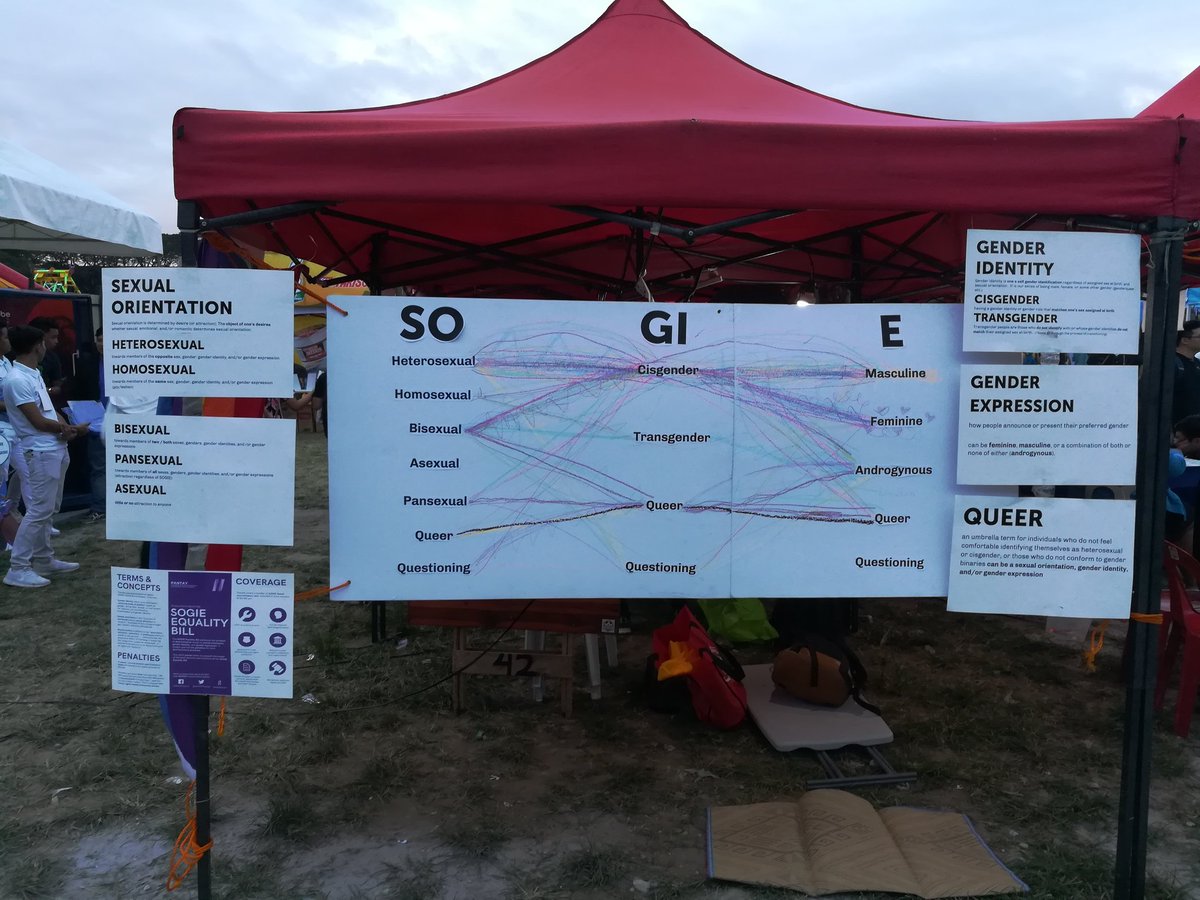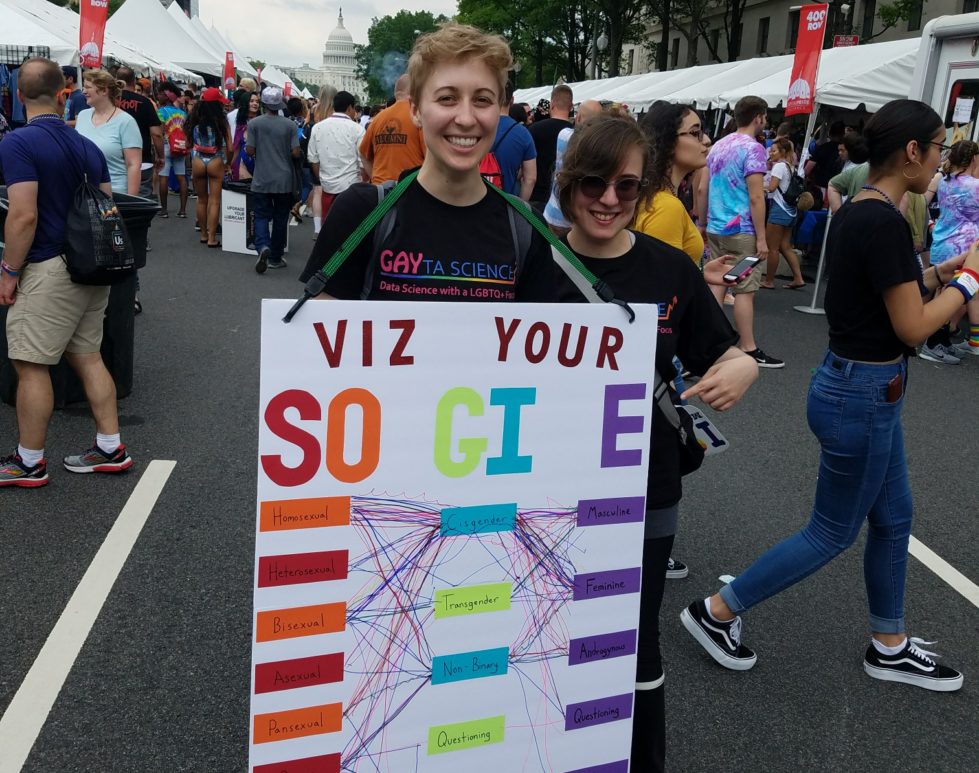A couple of us on the Gayta Science team decided to take the show on the road this past weekend! We hit DC Pride with the goal to create a collective data visualization of people’s SOGIE’s!
SOGIE is an acronym that stands for Sexual Orientation, Gender Identity, and Expression. Which means that EVERYONE has one, whether they are gay/straight/trans/cis/in-between/whatever! We included some of the largest categories in each column, but the range of experiences/identities/vocabulary for these things are really infinite - leading to some additions and a catch-all “Other” category.
"Dataviz Tofu" (as described by Gayta Science-r Cathryn Ploehn)

The idea was something I saw a few months ago on Twitter.

I absolutely loved it – what an amazing way to teach people about the different dimensions of identity AND show off the beautiful diversity within and between each in a dataviz way! We decided to go with a more mobile version for maximal fun/participation.

The experience was more beautiful than I ever could have imagined. It was incredible to see people teaching, learning, questioning, and understanding things in real time right in front of us! I was honestly so moved by the experience, and I want to share some of the moments and my takeaways with you here.
Top 10 Takeaways
1. Literally no one was an asshole! No one! Not one person invalidated any of the identities on the board! I was expecting at least a few people to be all “that’s not a real thing”. I know we were at Pride and all, but there is still a lot of misunderstanding and hate within the LGBTQ community!
2. In addition to no one being shitty about the board, no one was shitty to others when someone didn’t know what a term was! The biggest unknown was “cisgender” (ironically mostly by people who identified that way), but it was awesome to see people just ask when they didn’t know something, we/someone in their group tell them what it meant, and them just being like “Ok, cool” before drawing their line.
3. It was such a privilege to witness SO MANY learning moments for people who had never considered the 3 different dimensions, or who had never realized these facets of identity were separate things. There was such a range of self-awareness too – from people who would confidently march up and know exactly where to draw their line, to people who were legitimately having an identity crisis right in front of us with a marker in hand!
4. I think having the range of categories we did was exciting for people – especially those that don’t get a lot of explicit representation at Prides (Bi, Pan, Ace, Trans, Non-binary, etc). I also liked how there was a “Questioning” in each category – making it clear that this is a completely valid and ok place to be.
5. I loved how creative people are. Many people’s identities are so unique that we would never be able to capture them visually. I loved people who would come and draw multiple lines, split their lines, even adding categories that better defined them (“Soft Butch” haha). We also noticed as the viz got more and more filled in, more people started doing different things to “stand out” – making their line squiggly or darker for example. Color choice was also interesting. Many people were into pink. Green was probably the least popular, but the green people were also more about it – no contemplation, just “GREEN!” before drawing a thick, confident line.
6. I feel like we witnessed so many powerful personal moments. There were a good number of people that would come up alone, very quiet and shy, to draw their line. It felt like it was such a deeply personal thing that they wanted to do for themselves. I felt honored to be there.
7. With groups of friends it was amazing to see people educating others and helping them understand and talk through their own identities. Also, there were people coming out to their friends! Some of these identities might not come up in general conversation, so it was amazing that we were (unintentionally!) creating an accepting and inclusive space for people to learn about their friends.
8. There were many interesting conversations with people of older generations who participated. Comments like “Back in my day there was just butch and femme lesbians, there’s so many options nowadays!” It really shows just how far we have come in our understanding and availability of information. What a world we live in 🙂
9. There was an absolutely beautiful teaching moment with a mom and her two kids. She just went one by one explaining what each category was without judgement, explaining that they might not know what they are yet but here’s what people in that category might feel. She didn’t really sugarcoat any of the SO’s, just putting it all out there! I was blown away at how perceptive one of the kids was - saying things like “Noone has identified as Other-Other-Other yet!” (Mom: “Yea, that would be a very unique person!”) It was clear that they really understood the dataviz! I praised the mom as they were leaving, and she was like “No thank you I didn’t know how to bring that stuff up, but there they all were and I was like ok I guess we’re just gonna jump right in!” I thought she handled it beautifully.

Reminded me a bit of this comic.
10. I even learned an important lesson – you hear it all the time to not make assumptions about people based on their appearances, and it is so true! At the beginning, I would try and help people out if they were having trouble with the “Expression” category. You would think that would be pretty safe since it is literally the category about how you appear to others, right?! EVERY SINGLE TIME I WAS WRONG! Every time! You really just can’t assume things about people – even things that are in theory “for others”! This stuff is all about how you feel personally, and it is so different for each individual - which makes it so important to really listen.
So while the process was by far the most valuable part, the final dataviz is not too shabby!
Final DC Pride SOGIE Dataviz

We didn’t keep any official counts or anything, but visually we can see every single category was represented, and almost every combination too!
The “Homosexual – Cisgender” combo and “Cigender - Feminine Presenting” seem to have the thickest lines/most representation.
I got into an interesting conversation with someone about (what I’m going to call) the “Bi/Pan Rivalry”. In recent years, Bisexual has expanded to a “2 or more genders” definition which is dangerously close to Pansexual meaning of “all genders”. I know that it’s a personal preference and people are free to choose whatever label (if any!) that works for them and feels comfortable, but I still found it interesting 🙂 From the visualization it appears that Bisexual has the edge in the “rivalry” though (or was it just higher up?!).
Looking at the lines from “Non-Binary” to the “Expression” column was super interesting. There is a misperception that all non-binary people appear very androgynous. Yes, many do present that way, but there appears to be an equal amount of non-binary people that express themselves in a binary way! Again showing that you can’t make assumptions!
Just so many interesting inferences you can make from the final viz – let us know on Facebook/Twitter what stands out to you!
Overall, this experience was just extremely beautiful and enlightening. We can’t wait to do it again in the future, and have already brainstormed ways to improve the activity and make it more inclusive! In the meantime, check out more pictures from DC Pride here.

